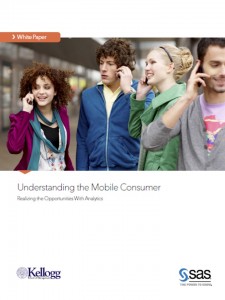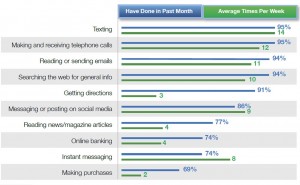 Why are they thinking that? And how is their customer experience different with mobile? As the world is going mobile, those were the questions on our mind as we kicked off an important research project with Northwestern University’s Kellogg School of Management (the Research). We were motivated to zero in on those questions because of all the technological advances that have transformed marketing of late, mobile is perhaps the biggest game-changer.
Why are they thinking that? And how is their customer experience different with mobile? As the world is going mobile, those were the questions on our mind as we kicked off an important research project with Northwestern University’s Kellogg School of Management (the Research). We were motivated to zero in on those questions because of all the technological advances that have transformed marketing of late, mobile is perhaps the biggest game-changer.
The advent of smartphones, tablets and wearable devices are key engagement portals that are driving a fundamental paradigm shift in how customers engage with organizations. As a result, how marketers engage with customers has to undergo an equally radical change.
Mobile is reshaping the customer experience
The Research indicates that the vast majority of respondents’ customer experience via mobile with businesses are still primarily passive, but are also highly influential on other interactions as evidenced by these specific findings:
- Three out of four respondents engage in showrooming, and a similar proportion uses their mobile device to check bank account and credit card balances,
- Roughly six in ten respondents use mobile to add an item to an online shopping cart for later purchase via laptop, and
- Over half of the consumers responded that they are opting in via mobile to receive information as well as promotional offers from businesses.
Consumers are app crazy
During 2014, we reached what ComScore has termed the “App Majority,” or when the majority of all digital media time spent occurs on mobile apps. The Research found that 95% of smartphone and tablet users have downloaded at least one app, while the average is 6 apps. At the same time, the most active apps identified were those for leisure or entertainment use: social media, games and music apps - not only the most downloaded, but the most used. And it turns out that banking, shopping and deal/promotional apps were the only business related apps in the top ten most actively used among the respondents.
Understand there is a gap
 The Research highlighted opportunities for organizations by addressing the gap between consumers’ expectations of mobile and the mobile experience they are actually provided. That idea is significant given the growing number of consumers for whom mobile is the “first screen” and primary portal to the internet. People use their phones and tablets to read and respond to emails on the go, search the web for information and directions, and post to social media. The Research found mobile serves as the ultimate transaction convenience, particularly for the functions shown to the right.
The Research highlighted opportunities for organizations by addressing the gap between consumers’ expectations of mobile and the mobile experience they are actually provided. That idea is significant given the growing number of consumers for whom mobile is the “first screen” and primary portal to the internet. People use their phones and tablets to read and respond to emails on the go, search the web for information and directions, and post to social media. The Research found mobile serves as the ultimate transaction convenience, particularly for the functions shown to the right.
Know the attitudes and the segments
To keep pace with the empowered consumer, it's critical to understand their attitudes around mobile. Doing that can guide strategy to capitalize on the marketing opportunities unique to the mobile environment. In additional to defining consumer mobile usage and behavior previously discussed, the Research provided insight into the attitudinal factors that impact mobile usage.
Those attitudinal factors driving mobile use patterns showed three distinct groups segmenting the mobile-active consumer market:
- Tech Reliant
- Security Concerned
- Human Touch
Each of those segments have attributes showing various stages of adoption and maturity in their use of mobile, similar to adoption curves for other new technologies.
Mobile > digital >data > analytics
Ultimately, it's the digital nature of mobile that enables brands to make customer engagements more personalized through marketing analytics. And that development enables the marketer to meet the new and changing expectations of their mobile customers.
These conclusions and more are detailed in the report based on the research, titled "Understanding the Mobile Consumer, Realizing the Opportunities with Analytics." I encourage you to download it and read for yourself what mobile consumers are thinking and doing, and what you can do about it.

2 Comments
Well, John., one thing mobile consumers don't think much about is their driving! But I made it home safely nonetheless after the "mobile device impaired" SUV driver in front of me sideswiped a telephone pole.
Seriously, it's about instant information, and the flexibility to take immediate action or at least immediately research a potential action. (By the way, the folks in the photo ought to be looking down on their screens rather than holding them to their ears; that would represent the most used "configuration" and also would be more relevant to the commercial usage model.)
I have friends that, during a leisurely evening at the pub, never seem to look me in the eye because they're focused on their devices - ugh. But I know they're paying attention to the conversation, because they contribute frequently in the form on facts and data just discovered through extensive thumbwork. I'll let social scientists weigh in on this as a behavior, but it certainly represents how instant mobile information access has permeated nearly every corner of our lives.
More to the point, the connectivity to just about every known piece of information on the planet, and the speed and ease at which that information can be accessed, is what creates this addiction we have to our devices. When it comes to planning an activity that may involve an outlay of funds and/or time, we naturally crave that extra info upon which a more informed decision can be made. It doesn't matter if it comes through an app or a browser, as long is it's relatively straight-forward and quick to get to.
Let the studies prove what we already know about mobile penetration into our lives, and let analytics describe that behavior in the necessary detail. I think that marketeers looking to reach people through the mobile "channel" need to keep in mind the usefulness of the info they're pushing out there and the ease with which that info can be found and acted upon.
Hi Mike,
Great points you make here! All of your points are relevant. There is certainly a lot to consider regarding mobile, and the way that individuals are using their phones is a big problem in many ways.
I am personally a big fan of AT&T's campaign to get people to stop using their phones while driving. And while hands-free options can mitigate some of the risks, the main issue is how mobile devices distract drivers - just as it impacts the quality of our social interactions. As you pointed out, the sad truth is that many people are heads-down in restaurants, bars and other places they should be engaged in other ways with those around them. One way to handle someone glued to their phone in a social situation is to text them in real-time with a friendly nudge to come back to the "real world" in front of them. :) [the smiley face is important when doing that]
That's the big issue also for marketers - our customers are distracted and empowered to potentially tune us out, so understanding the dynamics of use (and perceived utility) are hugely important to be sure your messages actually deliver value to those receiving them. Considering what has happened with other disruptive technologies can help us envision how all these issues will be resolved - part behavior modification and part technological innovation. But it will take time.